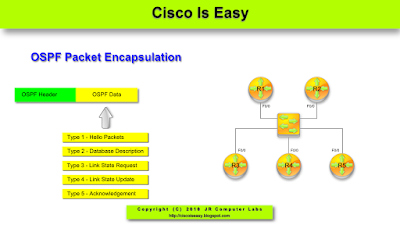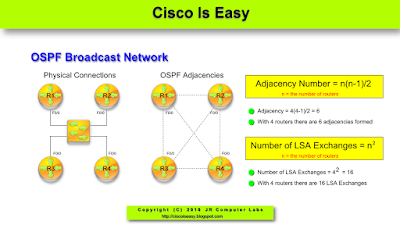Lesson 8 - Ethernet and Hub Operations
Lesson 8 - Ethernet and Hub Operations
After my last conversation with my son about building the home network I promised I'd explain to him how a hub worked. And now, he's showing at the door... . So, like in the previous lessons I'll focus on the most important aspects regarding CCNA level.
In order to explain how hub works, let me talk about the Ethernet technology first. Ethernet sets the rules regarding how data coming down from the upper layers (Layers 5 through 3) should be placed on the media. It defines such transmission aspects like the maximum speed, cable type and length, connector types, how frame should be structured etc. In other words, Ethernet defines both the layer 2 and the layer 1 of our OSI model. The reason the layer 3 cannot send data directly onto the media is that there are different, disparate media types and technological limitations related to them. For instance, there will be different way of transmitting data between Ethernet switches and two computers using modems to communicate. That is why, we need the layer 2 as a "translator" so the layer 3 protocol can use different types of media without re-writing its functions. Besides Ethernet, there were other protocols in use such as Token-Ring, but today Ethernet seems to be the most commonly used solutions in local area networks (LANs).
Initially, Ethernet used coaxial cable that was terminated on both ends, and the computers were attached to the cable using so called 'T-connectors'. They shared the media, and as a result of that, they shared the available bandwidth. Today, coaxial cable is not used that often. Instead, we use UTP cable (details in the Lesson 7). But the logic of operation in both cases is quite similar.
Ethernet, using a coaxial or a UTP cable (with the hub as concentrator connecting hosts), is based on the idea that only ONE computer can transmit something at a time. Other computers will ALL receive this signaland have to wait for their turn if they have something they want to transmit (Pic 1).
Pic1. Ethernet transmissions in bus (coaxial cable) and star topology (UTP cable + hub).
There is no arbiter to decide who can talk in a given time. Instead, the devices have a mechanism allowing them to 'sense' the wire to see if there is any transmission in progress. If not, they can use the media. However, if a host is already transmitting and, some other hosts "thinks" the medium is not used and starts transmitting as well, this phenomenon is called a collision. In that case, both senders will stop their transmission and wait a specified by the algorithm time before they try again. How long they have to wait is determined by so called back off algorithm. Needles to say, the more collisions occur the longer the hosts have to wait before they retransmit corrupted bits. The mechanism of checking the wire before transmission, detecting and reacting to collisions is known as CSMA/CD (carrier sense, multiaccess with collision detection).
The major downsides of this approach are the security (everyone "hears" everyone else), and the fact that only one computer can send data across the network at a time. What's worse, it can either transmit or receive bits (half duplex). The more computers you throw in the network, the harder is for them to get a chance to send something. Also, the chances for collisions are higher. In fact, collisions are imminent and make the system perform poorly.
HUB
A hub is a simple type of concentrator used to connect multiple computers, servers, printers etc., together. It is considered a layer 1 device due to the fact that it does not understand any headers. All it recognizes are electrical signals representing 1s and 0s. Hub operation is very simple. If signals appears on one port (interface), it is replicated on to all other active interfaces like depicted in picture 1 (right hand side).
Since hubs follow Ethernet rules in which there can be only one sender at a time, and because they transmit bits out of all remaining ports, they maintain one single collision domain.
A collision domain could be defined as any group of devices which can receive transmissions from other hosts. So, hubs are not seriously considered to be a proper solution in medium/large networks. The problem with the collisions, typical in hub-based networks, has been solved by introducing another type of concentrators called bridge (old, software-based device) and switch (modern, hardware-based device) equipment used in the layer 2 of OSI mode.
Discussion on bridges and switches though, are the topic I reserve for the next lesson.
In order to explain how hub works, let me talk about the Ethernet technology first. Ethernet sets the rules regarding how data coming down from the upper layers (Layers 5 through 3) should be placed on the media. It defines such transmission aspects like the maximum speed, cable type and length, connector types, how frame should be structured etc. In other words, Ethernet defines both the layer 2 and the layer 1 of our OSI model. The reason the layer 3 cannot send data directly onto the media is that there are different, disparate media types and technological limitations related to them. For instance, there will be different way of transmitting data between Ethernet switches and two computers using modems to communicate. That is why, we need the layer 2 as a "translator" so the layer 3 protocol can use different types of media without re-writing its functions. Besides Ethernet, there were other protocols in use such as Token-Ring, but today Ethernet seems to be the most commonly used solutions in local area networks (LANs).
Initially, Ethernet used coaxial cable that was terminated on both ends, and the computers were attached to the cable using so called 'T-connectors'. They shared the media, and as a result of that, they shared the available bandwidth. Today, coaxial cable is not used that often. Instead, we use UTP cable (details in the Lesson 7). But the logic of operation in both cases is quite similar.
Ethernet, using a coaxial or a UTP cable (with the hub as concentrator connecting hosts), is based on the idea that only ONE computer can transmit something at a time. Other computers will ALL receive this signaland have to wait for their turn if they have something they want to transmit (Pic 1).
Pic1. Ethernet transmissions in bus (coaxial cable) and star topology (UTP cable + hub).
Switch/router/computer icons designed by: Andrzej Szoblik - http://www.newo.pl
- Carrier Sense - "listen" to the wire to see if you can transmit.
- Multiple Access - multiple hosts share the bandwidth and only one computer can send or receive bits but not both at the same time (half-duplex).
- Collision Detection - in case other computer(s) started transmitting while other transmission is in progress, detect it and use back off algorithm.
The major downsides of this approach are the security (everyone "hears" everyone else), and the fact that only one computer can send data across the network at a time. What's worse, it can either transmit or receive bits (half duplex). The more computers you throw in the network, the harder is for them to get a chance to send something. Also, the chances for collisions are higher. In fact, collisions are imminent and make the system perform poorly.
HUB
A hub is a simple type of concentrator used to connect multiple computers, servers, printers etc., together. It is considered a layer 1 device due to the fact that it does not understand any headers. All it recognizes are electrical signals representing 1s and 0s. Hub operation is very simple. If signals appears on one port (interface), it is replicated on to all other active interfaces like depicted in picture 1 (right hand side).
Since hubs follow Ethernet rules in which there can be only one sender at a time, and because they transmit bits out of all remaining ports, they maintain one single collision domain.
Pic. 2 - Hubs maintain one single collision domain.
A collision domain could be defined as any group of devices which can receive transmissions from other hosts. So, hubs are not seriously considered to be a proper solution in medium/large networks. The problem with the collisions, typical in hub-based networks, has been solved by introducing another type of concentrators called bridge (old, software-based device) and switch (modern, hardware-based device) equipment used in the layer 2 of OSI mode.
Discussion on bridges and switches though, are the topic I reserve for the next lesson.




Comments
Post a Comment